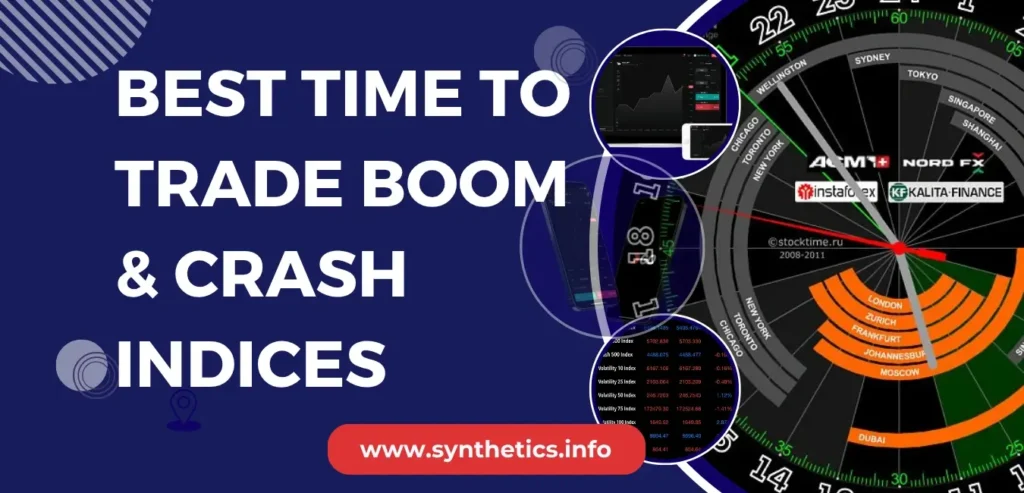Why Timing Matters for Boom & Crash
“I used to think Boom & Crash were just chaos engines — spikes flying in randomly, 24/7. But once I started logging trades by time of day and day of week, patterns started showing up.”
Then I ran the numbers.
Across Boom 300 to Crash 1000, certain sessions consistently show bigger ranges. Some peak on Sundays, others on Tuesdays. This guide reveals the clearest patterns — backed by 12 months of real volatility data.
🔍📊 How I Collected the Data For The Best Time TO Trade Boom & Crash
Most guides just throw out random “best times” with no evidence. This one doesn’t.
I pulled one full year of 30-minute candles for each Boom and Crash index — from July 2024 to July 2025 — and broke them down step by step:
- 🔹 Converted each candle’s point range into USD, using official Deriv lot size data for each index
- 🔹 Calculated average, minimum, and maximum 30-minute ranges — both in points and in dollars
- 🔹 Mapped the most active sessions and weekdays by looking at which hours and days had the highest average range
- 🔹 Ranked all 10 indices based on their behavior during different times of the day and week
This isn’t guesswork or YouTube hype. It’s a real, data-backed guide built on over 100,000 candles — showing how each index actually moves.
👇 You can find the full point-to-dollar conversion method just below this section.
💰 Boom & Crash Point-to-Dollar Conversion Guide
Each index has a fixed “value per point” — meaning every point move has a predictable dollar amount based on the smallest trade lot size (0.2 for all Crash & Boom Indices)
$0.00002 per point (50,000 points = $1)
- Boom 1000
- Crash 1000
$0.0002 per point (5,000 points = $1)
- Boom 900
- Boom 600
- Boom 500
- Crash 900
- Crash 500
$0.0002 per point (10,000 points = $2)
- Crash 600
$0.00005 per point (60,000 points = $3)
- Crash 300
$0.001 per point (2,000 points = $2)
- Boom 300
🧮 Want to calculate exactly how much a move is worth in your index?
👉 Try the calculator below to convert points into real USD.
🧮 Boom & Crash Point to Dollar Calculator
🔥 Tier 1: Most Active Indices (Best for Scalping)
| Index | Avg Daily Range (USD) | Peak Hour (UTC) | Peak Day |
|---|---|---|---|
| Boom 500 | $33 | 11:00 | Tuesday |
| Boom 300N | $30 | 08:00 | Tuesday |
These two indices consistently show the highest dollar movement day after day. Boom 500, in particular, peaks during late morning (11:00 UTC), making it a strong candidate for structured scalping strategies.
Best session: 07:00–12:00 UTC (Europe open)
Avoid: 00:00–05:00 UTC where movement dies down
⚖️ Tier 2: Medium Volatility (Best for Swing & Intraday Plays)
| Index | Avg Daily Range (USD) | Peak Hour | Peak Day |
|---|---|---|---|
| Boom 600 | $29 | 14:00 | Sunday |
| Boom 900 | $27 | 19:00 | Monday |
These indices move well — not quite Tier 1 pace, but smooth enough for structured pullbacks or H1 swing trades. Boom 900 peaks around 19:00 UTC, lining up well with early US session.
Best session: 14:00–20:00 UTC
Watch for reversals on Monday and Sunday
🐢 Tier 3: Low Movement Indices (Slow but Safe)
| Index | Avg Daily Range (USD) | Peak Hour | Peak Day |
|---|---|---|---|
| Boom 1000 | $9 | 00:00 | Tuesday |
Boom 1000 shows extremely low daily volatility in USD terms. This may be ideal for beginners testing strategies or for holding longer-term structures without sudden spikes.
Best for range trading or testing strategies
Avoid trading it actively for quick gains
⚠️ Dead Zones to Avoid
Across all indices, some common patterns showed up:
- Quietest hours: 00:00–05:00 UTC
- Quietest days: Sunday and Friday (for most indices)
If you’re taking entries during these times, expect more false signals and slower moves.
📌 Summary
| Index | Tier | Best Hour | Worst Hour |
|---|---|---|---|
| Boom 500 | 🔥 | 11:00 | 14:00 |
| Boom 300N | 🔥 | 08:00 | 19:00 |
| Boom 600 | ⚖️ | 14:00 | 11:00 |
| Boom 900 | ⚖️ | 19:00 | 21:00 |
| Boom 1000 | 🐢 | 00:00 | 12:00 |
🕒 Best Session to Trade Each Index (UTC Hour)
| Index | Best Session (UTC) | Notes |
|---|---|---|
| Boom 1000 | 00:00–01:00 | Early spike and reversal setups |
| Boom 600 | 14:00 | Afternoon volatility, especially midweek |
| Boom 500 | 21:00 | Pre-reset breakouts |
| Boom 300N | 14:00 | Consistent intraday rhythm |
| Crash 1000 | 07:00 | London session structure breaks |
| Crash 900 | 14:00 | Midday slingshots |
| Crash 600 | 14:00 | Overlap stretch entry setups |
| Crash 500 | 09:00 | Post-London fakeouts |
| Crash 300N | 09:00 | Quiet enough for small-lot scalps |
📅 Best Day to Trade Each Index
| Index | Most Volatile Day |
|---|---|
| Boom 1000 | Wednesday |
| Boom 600 | Tuesday |
| Boom 500 | Tuesday |
| Boom 300N | Sunday |
| Crash 1000 | Wednesday |
| Crash 900 | Tuesday |
| Crash 600 | Tuesday |
| Crash 500 | Tuesday |
| Crash 300N | Sunday |
➡ Notice how Tuesday dominates? Mid-week is prime for spikes and range breaks.
Want deeper stats for Boom 1000 specifically?
Check out the full Boom 1000 Index Strategy Guide — includes average daily spikes, top trading days, and more.
🧠 Real Tip from Testing These
I’ve personally found that Boom 300N and Boom 500 offer the cleanest movement for scalping during European mornings. Meanwhile, Boom 900 gives nice trends in the evening if you're patient.
Avoid forcing trades during the dead zones — even if your setup looks clean. Most failures I’ve had in testing were during 02:00–05:00 UTC when the index just didn’t have juice.
🧩 How to Use This Info
For Scalpers:
- Boom 600 and Crash 600 at 14:00 UTC are prime. Tuesdays and Wednesdays offer max juice.
For Range Traders:
- Crash 1000 and Boom 1000 during London hours are cleanest.
For Weekend Traders:
- Boom 300N and Crash 300N stay active even on Sundays — ideal for small positions or testing new setups.
🗺️ Suggested Trading Windows by Strategy
| Strategy Type | Best Index | Best Time (UTC) | Best Day |
|---|---|---|---|
| High-vol scalp | Boom 600 | 14:00–15:00 | Tuesday |
| Trend swing | Boom 1000 | 07:00–11:00 | Wednesday |
| Reversal setup | Crash 900 | 14:00 | Tuesday |
| Weekend test | Boom 300N | 14:00 | Sunday |
✅ Conclusion: Build Your Week Around This Map
You don’t need to trade all 10 indices. Pick 2–3 that suit your risk level, and match them to these hot windows.
👉 Download the full session matrix or screenshot your top 3 and pin them to your trading dashboard.
📌 Related Guides
- 🧠 How Boom & Crash Indices Work
- 📈 Boom & Crash Strategy PDF
- 📊 Lot Sizes for Synthetic Indices
- 🕒 Best Time to Trade Volatility Indices
- 📘 Full Synthetic Index Breakdown
❓ FAQs: Best Time to Trade Boom & Crash
Yes — Boom 300N and Crash 300N spike most on Sundays, great for weekend traders.
14:00 UTC is a hotspot across multiple Boom & Crash pairs. Most indices show strong spikes around this window.
oom 500 is currently the most consistently active in USD terms — best for scalping or momentum setups.
Yes, but not for quick profits. It suits range strategies or long setups with tighter risk.
Midday to evening (14:00–20:00 UTC) offers the most volatility across most Boom and Crash indices. Boom 600 and Crash 900 peak around 14:00 UTC.
uesday and Wednesday consistently offer higher movement across all indices, especially for Boom 600, Crash 900, and Boom 1000.






💼 Recommended Brokers to Explore
Other Posts You May Be Interested In
Boom and Crash Indices on Deriv (2025 Guide)
📅 Last updated: July 10, 2025 ✍️ Written by: Jafar Omar ✅ Fact-checked by: Taylor [...]
Deriv TradingView Integration: How to Use It with Synthetic Indices (2025)📊
📅 Last updated: June 27, 2025 ✍️ Written by: Jafar Omar ✅ Fact-checked by: Taylor [...]
⏱️ When to Trade Each Volatility Index on Deriv — Data-Driven Session Map
📅 Last updated: June 13, 2025 ✍️ Written by: Jafar Omar ✅ Fact-checked by: Taylor [...]
How To Withdraw From Deriv Account 💰 (Complete 2025 Guide)
📅 Last updated: July 26, 2025 ✍️ Written by: Jafar Omar ✅ Fact-checked by: Taylor [...]
How to Trade Deriv Drift Switch Indices (DSI 10, 20, 30 Explained)
📅 Last updated: July 3, 2025 ✍️ Written by: Jafar Omar ✅ Fact-checked by: Taylor [...]
HFM Zero Spread Account Review
📅 Last updated: October 31, 2023 ✍️ Written by: Jafar Omar ✅ Fact-checked by: Taylor [...]